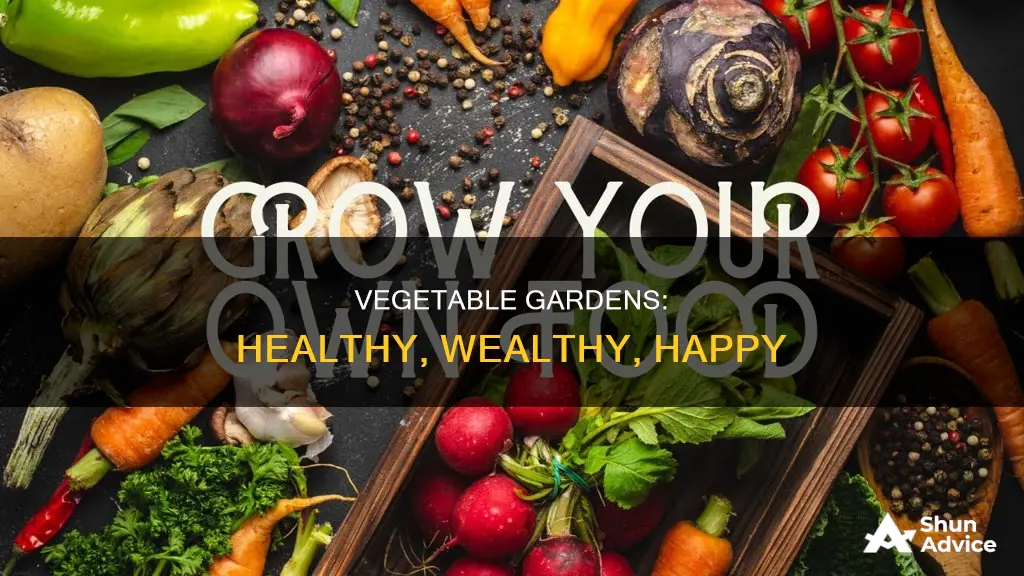
Vegetable gardens are a great investment for many reasons. They can save you money on groceries, increase your confidence in food safety and security, and provide physical exercise. With the rising costs of groceries, growing your own vegetables can be a cost-effective way to access fresh, healthy food. Vegetable gardens also allow you to know the history of your plants, including what chemicals were used and what pests were an issue. Additionally, gardening is a great form of physical activity, and the produce is good for your health.
While there are upfront costs associated with starting a vegetable garden, such as tools, equipment, fertilizers, and water, the long-term benefits can outweigh these initial expenses. It is important to start small and choose the right location for your garden, ensuring it receives ample sunlight and has good drainage.
Vegetable gardens can be rewarding, providing a sense of accomplishment and the opportunity to connect with nature. They can also be a fun hobby to share with neighbours and friends, potentially reducing costs further by trading produce.
| Characteristics | Values |
|---|---|
| Cost-effectiveness | Growing your own vegetables can save money and reduce the grocery bill, especially if you grow expensive vegetables such as tomatoes and melons. |
| Health benefits | Gardening is a great form of physical exercise and fresh produce is good for you. |
| Food safety and security | You know where the food is coming from, what chemicals were used, and what pests were a problem. |
| Environmental impact | Gardening eliminates the resource-gobbling transportation chain to get the food to your plate. |
| Taste | Home-grown vegetables taste better than those from the grocery store. |
What You'll Learn

Save money on groceries
The Benefits of a Vegetable Garden
Growing your own vegetables can be a great way to save money on groceries, but it requires careful planning and execution to be cost-effective. The potential to save money depends on various factors, including the costs of setting up and maintaining the garden, the types and amounts of vegetables grown, and the yields produced.
Tips for Saving Money with a Vegetable Garden
- Limit costs while maximising yield: Keep expenses low by being mindful of the costs of tools, equipment, fertilisers, pesticides, and water.
- Select vegetables you like and will eat: Choose vegetables that you and your family enjoy and will take care of. Avoid wasting time and money on plants that may be neglected or left uneaten.
- Choose vegetables with good storage or preservation options: Opt for vegetables that can be easily stored, canned, or frozen to extend their shelf life and reduce waste. Examples include potatoes, onions, sweet potatoes, and winter squash.
- Grow expensive or frequently purchased vegetables: Focus on vegetables that are typically pricey at the grocery store, such as tomatoes, melons, or items you buy regularly in large quantities.
- Research and plan: Decide what you want to grow and create a plan. Consider factors such as the type of vegetables, the necessary equipment, and the space required. Reach out to your local county extension office for guidance and resources.
- Reduce input costs: Look for ways to minimise expenses. Collect rainwater for irrigation, use compost and manure to improve soil quality, and practice integrated pest management to reduce pesticide reliance.
- Start small and practice succession planting: Begin with a small garden to avoid becoming overwhelmed. Focus on a few types of vegetables initially, and as you gain experience and confidence, expand your garden and diversify your crops. Succession planting involves using the same space for multiple crops, allowing you to maximise your growing area.
- Have fun and connect with others: Growing your own vegetables can be enjoyable, and you can encourage your neighbours to do the same. Trading produce with others can lead to a sense of community and help you save money by diversifying your options.
Examples of Cost-Effective Vegetables to Grow
Some specific vegetables that can provide significant savings include:
- Tomatoes: Growing your own tomatoes can be highly cost-effective, especially if you buy organic or heirloom varieties. A single plant can yield multiple pounds of tomatoes, and they are easy to grow in containers or cages.
- Leafy greens: Leaf lettuce, spinach, and arugula are easy to grow and provide a continuous supply of fresh greens for salads and sandwiches.
- Herbs: Fresh herbs like basil, mint, rosemary, and thyme can be expensive at the store, but they are simple to grow at home and add flavour to your meals.
- Squash and zucchini: These vegetables are expensive out of season, but they are very productive and can be frozen for later use.
- Peppers: Poblano, jalapeño, and bell peppers are pricey at the grocery store but easy to grow at home, providing a high yield for a low investment.
By following these tips and choosing the right vegetables to grow, you can effectively save money on groceries by investing time and effort into your vegetable garden. Not only will you save money, but you'll also enjoy the benefits of fresh, healthy produce and the satisfaction of growing your own food.
Retirement Account: Investing Beyond $5500
You may want to see also

Improve food safety and security
Vegetable gardens can improve food safety and security in several ways. Firstly, they provide knowledge and control over the food source. Gardeners know the history of their plants, including the chemicals used and the pests encountered. This transparency can increase confidence in the safety of the food on one's plate.
Secondly, vegetable gardens eliminate the transportation chain, reducing the resources required to get food from farm to table. This not only saves resources but also ensures a steady food supply by mitigating the impact of disruptions in the industrial food system.
Thirdly, vegetable gardens promote healthy eating by providing access to fresh produce. Growing one's own vegetables encourages the consumption of nutritious food, which can be beneficial for both physical and mental health.
Lastly, vegetable gardens can help families produce their own food organically, which is especially beneficial for those who value organic foods but are hesitant to pay the higher prices at the grocery store. Organic vegetable gardens allow consumers to enjoy the benefits of organic produce without the added cost.
In summary, investing in vegetable gardens can improve food safety and security by increasing transparency and control over the food source, reducing dependence on the industrial food system, promoting healthy eating, and providing an affordable way to access organic produce.
Boston Dynamics: The Future of Robotics
You may want to see also

Get physical exercise
Gardening is a great form of physical exercise. It is similar to other moderate to strenuous forms of exercise like walking and bicycling. Gardening works all the major muscle groups: legs, buttocks, arms, shoulders, neck, back and abdomen. Tasks that use these muscles build strength and burn calories.
Digging, lifting bags of mulch and pushing wheelbarrows all provide strength training similar to weight lifting, leading to healthier bones and joints. There is also minimal jarring and stress on the body, unlike aerobics or jogging.
Gardening can help keep you limber since there is often a great deal of stretching involved, like reaching for weeds or branches, bending to plant or extending a rake.
According to Harvard Medical School, in a 30-minute gardening session, a 155-pound person burns:
- 149 calories planting seedlings or raking
- 172 calories weeding
- 186 calories digging and spading
- 205 calories mowing with a push lawnmower
To get the most out of gardening as a form of exercise, it's important to vary your tasks and movements to engage different muscle groups. For example, try switching hands when raking or shovelling, or change activities every 15 to 30 minutes. This can also help break up the monotony of performing the same activity over and over.
Makeup Investment: Who's Spending?
You may want to see also

Save money on herbs
Herbs are a great way to save money when vegetable gardening. Fresh herbs are very expensive to buy at the grocery store, but they are economical to grow at home.
If you're looking to save money on herbs, you can either spend $3 on a single fresh sprig or buy a four-pack of starter plants. This is where the savings really add up: each plant can produce 50 times as much as what you can get for that $3 at the supermarket.
For example, if your four herb plants each produce 50 sprigs, you just saved $600 this season on herbs. However, this is a lot of herbs! Even if you only use the yield of one crop, your savings equals $150. You can freeze the rest using filled ice cube trays to use over the winter.
Herbs will need 4-6 hours of sunlight per day. Make sure to clip the flower buds for maximum flavor.
Some of the easiest herbs to grow include:
- Basil
- Parsley
- Mint
- Sage
- Rosemary
- Thyme
- Chives
- Cilantro
- Dill
- Oregano
- Lemon balm
Shark Tank: Payback Time?
You may want to see also

Save money on expensive vegetables
Growing your own vegetables can be a great way to save money on expensive grocery store produce. While it's possible to spend a lot of money on a garden, there are ways to keep costs down and maximize your yield. Here are some tips to help you save money on expensive vegetables by growing them yourself:
- Grow expensive vegetables: Focus on growing vegetables that are typically more expensive at the grocery store, such as tomatoes, melons, peppers, and herbs. These items tend to provide a higher return on your investment of time and space.
- Select vegetables you like: Choose to grow vegetables that you and your family will actually enjoy eating. This may seem obvious, but it's important not to waste time and money planting things that will go uneaten.
- Start small: Gardening takes practice, so it's best to start with just a few types of vegetables in your first year. You can always expand your garden once you feel more confident in your abilities and resources.
- Do your research: Before you start planting, take the time to research and plan your garden. Decide what you want to grow and determine the necessary steps for success. Reach out to your local county extension office or master gardeners for advice and resources.
- Reduce input costs: Keep costs down by reusing containers, collecting rainwater for irrigation, and adding compost to improve soil quality. Start with high-quality seeds, which are typically inexpensive and can be stored for future use.
- Practice succession planting: Succession planting involves using the same space to grow two or more crops in succession during the growing season. This technique maximizes the efficiency of your garden space and can lead to greater savings.
- Preserve your harvest: Choose vegetables that can be easily stored, canned, or frozen to extend their shelf life. This way, you can enjoy your produce beyond the week of harvest and reduce the need to buy vegetables from the store.
- Grow from seeds: Starting with seeds instead of buying mature plants can save you money. Give your seeds a home-grown start and spread the risk over several tiny plants. Pick the strongest ones for transplanting outdoors.
- Try square foot gardening: If you have limited space, consider square foot gardening. This technique is highly effective at producing healthy plants with minimal effort and space. It can be done in a small garden box or directly in the ground.
- Join a community of growers: Encourage your neighbors to grow their own vegetables as well. You can trade tips, share extra produce, and support each other through the joys and challenges of gardening.
By following these tips and adapting them to your specific context, you can save money on expensive vegetables by growing them yourself. Not only will you benefit financially, but you'll also enjoy the satisfaction of eating fresh, healthy produce from your own garden.
GME: The People's Investment
You may want to see also
Frequently asked questions
Vegetable gardens can save money, provide access to fresh produce, and promote physical activity.
The savings depend on various factors, such as the costs of seeds, tools, water, etc. On average, home vegetable gardens produce $677 worth of fruits and vegetables, with costs of materials and supplies around $238.
Tomatoes, salad greens, root vegetables (radishes, beets, carrots), and cucumbers are great options for beginner gardeners. These plants have varying sunlight requirements and are generally low-maintenance.
It's recommended to start small, with a plot size of 6x6 feet for beginners. If planting directly in the ground, a 10' x 10' plot is ideal, while a raised bed garden can be smaller, around 4' x 8'.
Ongoing costs include water, nutrients/fertilizers, tools, and pest control measures. These costs can be minimized by using compost, collecting rainwater, and choosing the right plants for your climate and sunlight conditions.







